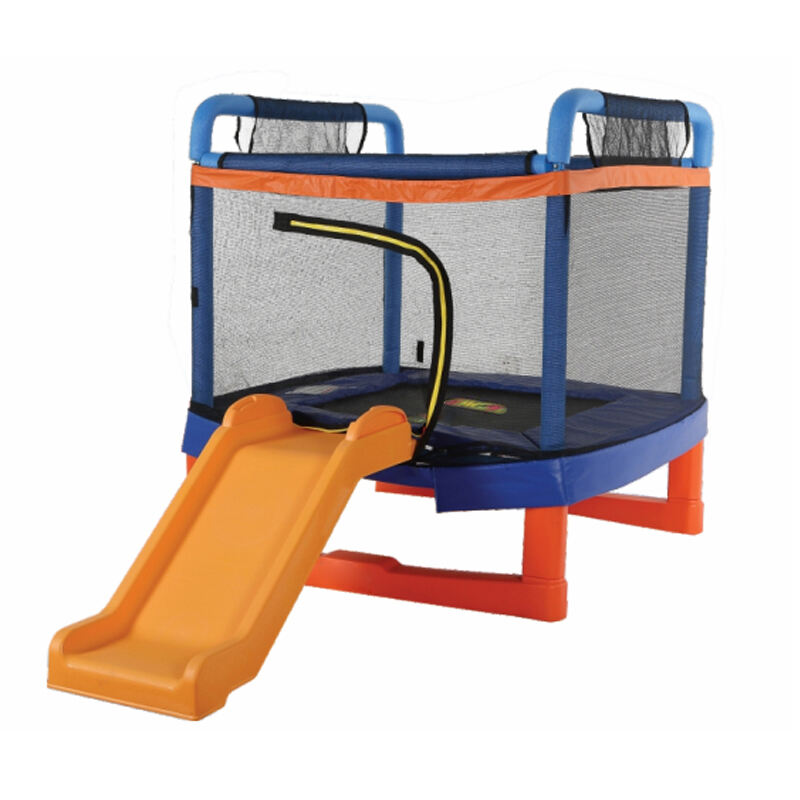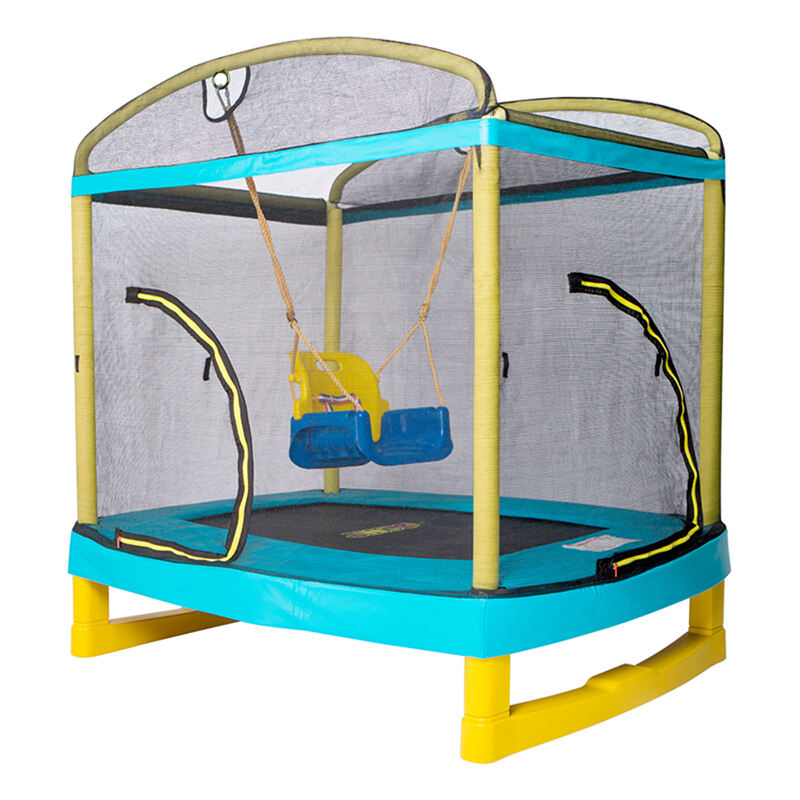Although trampolines are fun for kids, they come with real dangers such as falling off, bumping into others, or landing wrong. Parents and caregivers should definitely know about these risks when their children are using trampolines. Most injuries happen because someone lands incorrectly or gets hit while jumping in the air. These accidents can cause anything from simple sprained ankles all the way up to serious back problems. Given how many different ways things can go wrong, it makes sense to treat trampoline time carefully and always have an adult watching closely nearby.
The numbers tell a pretty concerning story about trampoline injuries. Emergency rooms across the country see thousands of kids coming in every year after bouncing mishaps. A recent report from pediatricians shows that last year alone saw more than 100 thousand people injured on trampolines. These kinds of stats should really make parents think twice before letting their little ones jump around unsupervised. After all, what looks like fun can quickly turn dangerous without proper safety equipment and adult supervision nearby.
Most experts agree little ones under six years old shouldn't jump on trampolines because they're just too prone to getting hurt. For school aged kids between 6 and 12, constant adult watchfulness makes all the difference when they're bouncing around. These safety measures really matter since younger children haven't developed the coordination or judgment needed for safe trampoline use. Parents need to keep an eye out for risky behavior like attempting flips or wrestling matches that could result in broken bones or worse injuries. The reality is trampolines can be deadly if proper oversight isn't maintained, especially during those early developmental years.
The Single Jumper Rule makes all the difference when it comes to keeping people safe on trampolines. According to data from Complete Care, around three out of four trampoline injuries happen when multiple folks are bouncing at once. Making sure just one person jumps at any given moment cuts down dramatically on those painful face plants and bumps. The idea behind this basic safety measure is pretty straightforward – no one wants to land where someone else is about to be. We've seen families implement this rule successfully, especially with younger kids who tend to forget about spacing issues. While it might seem restrictive at first glance, most trampoline owners find that sticking to single jumper sessions actually enhances enjoyment since everyone gets their turn without worrying about accidents.
A trampoline safety net ranks among the most important safety features available today. Research shows these nets really work at stopping kids from falling off equipment. Some data suggests that when properly installed around a trampoline, safety nets cut down on injuries somewhere around half the time. The main benefit? They stop those dangerous flips and jumps that send children tumbling over the edge. Parents sleep better knowing their kids aren't going to land on hard ground after an accident. For families wanting to create a safer backyard environment, installing one of these nets should definitely be part of the plan. It's not just about following rules anymore it's becoming standard practice for responsible outdoor play areas.
Stunts and flips on trampolines really should be avoided if we want to keep kids from getting seriously hurt. According to people who know about safety stuff, doing flips or other acrobatic moves puts the neck and head at risk for injuries that might last forever or even worse. Parents would do better focusing on teaching little ones how to just bounce up and down safely first. Most instructors agree that consistent practice of these basic techniques makes all the difference. After all, when it comes to trampoline safety, simplicity works best for cutting down those accident chances significantly.
When kids jump around on trampolines, someone needs to keep an eye on them. Studies show that if there's an adult watching over things, the chance of getting hurt drops dramatically – somewhere around 90% according to some research we've seen. What adults should do? They need to teach proper techniques and step in whenever they spot something dangerous happening. Safety equipment like nets and padding helps, sure, but accidents still happen sometimes. We all know how fast those little ones can get out of control mid-air!
Keeping trampolines in good shape matters just as much as making sure kids have fun on them. Parents should get into the habit of looking at things like worn padding around the edges and torn spots in the safety net from time to time. Most folks find that checking these areas every two weeks works pretty well for catching small problems before they turn into big ones. When parents stay on top of this stuff, not only does it help extend how long the trampoline lasts, but it also gives peace of mind knowing little ones are safer while they jump around and play all day long.
Where we put the trampoline makes all the difference when it comes to staying safe while using it. The spot needs to be completely flat so nobody slips or trips during those jumps. Industry guidelines actually recommend finding an open space without any bumps or obstacles around. When the ground isn't level, things get dangerous fast because the trampoline might start tilting one way or another. This creates really unstable conditions for anyone bouncing on it, which naturally increases chances of falling off and getting hurt. Stick to these basic rules about placement and everyone will have better fun without worrying about accidents happening.
To make sure kids stay safe while bouncing on trampolines, parents need to check what's around them first. Get rid of anything dangerous nearby like branches hanging overhead, lawn chairs left lying about, or those old gardening shears nobody ever picks up. A clear space around the trampoline really matters because accidents happen when people tumble unexpectedly. Plus having enough room makes for better jumping fun without worrying about bumping into something hard. Most families find they spend time clearing out areas before setting up their bounce pads anyway.
Using trampoline ladders safely matters a lot for keeping everyone safe. Kids need to learn how to climb up and down properly so they don't slip or fall off. Younger ones especially have trouble balancing sometimes. For little kids who might wander over while parents aren't looking, taking the ladder away when nobody's jumping around makes good sense. That way curious toddlers can't just climb up without supervision.
We should keep our furry friends away from the trampoline too since they tend to get curious about jumping things. Pets just don't know their own strength sometimes and could knock someone off balance or start barking when someone lands nearby. A good solution? Install some sort of fence around the trampoline area. Most people find that works wonders for keeping dogs and cats at bay while still allowing kids to enjoy their bounce time safely. Plus, having those boundaries actually helps everyone understand where the fun zone ends and regular yard space begins.
Looking for something fun yet safe for kids who love bouncing around? The 5.2ft Trampoline for Kids Exercise Rebounder with Safety Net Slide stands out from the crowd. What sets this one apart? Well, there's that sturdy safety net all around which keeps little ones from tumbling off unexpectedly. Plus, the included slide makes getting on and off super convenient for parents too tired to constantly lift their kids up after every jump session. Built to last, this trampoline handles up to 80 kilograms before showing any signs of wear, so families don't need to worry about replacing it as their children get bigger and heavier over time.

The Jingyi 6.5 foot kids trampoline with slide is worth considering too since it works well whether playing inside or outside. Built tough with plenty of padding around the edges, this model suits most kids between about 3 and maybe 10 years old. What stands out are those thick steel legs holding everything together plus that safety netting that keeps little ones from falling off意外地. Parents get peace of mind knowing their children can bounce away happily without worrying about getting hurt during playtime.

These trampolines not only enhance safety but also promote active play for children, helping them develop coordination and physical strength in a controlled environment.
Getting kids up to speed on trampoline safety really matters for keeping them from getting hurt. One of the first things to teach is no doing flips unless they know what they're doing because messed up flips often result in serious head or neck problems. Only having one kid bouncing at once makes sense too since folks tend to crash into each other when there's more than one person jumping around. And don't forget those entry and exit points either. Kids need to learn proper ways to climb onto the trampoline and step down carefully so they don't slip or fall while getting on or off. Simple steps like holding onto the sides until ready to jump can make all the difference.
Teaching kids to listen up and follow instructions really makes a difference when it comes to staying safe around trampolines. According to those who know safety stuff, children who get what the rules are tend to stay out of trouble and avoid getting hurt. Once little ones learn why jumping on a trampoline without proper precautions is dangerous, they usually start respecting boundaries and following safety guidelines. This creates not only a safer environment but also lets everyone have more fun without constant worry. Parents should remember that regular reminders about safety practices plus actual supervision while kids play on trampolines goes a long way toward keeping injuries at bay.
Parents looking for ways to keep their kids active might want to consider options beyond regular trampolines, which can be pretty dangerous if not supervised properly. Mini trampolines made for younger children actually work better in most cases since they typically have built-in handles and much smaller jumping areas that limit how far little ones can go. And let's face it, who hasn't seen kids flip off big trampolines? For outdoor fun, old fashioned games still rule the day. Things like hopscotch chalked on driveways, classic tag where everyone chases each other around the yard, or creating an obstacle course using garden tools and patio furniture give kids plenty of exercise while keeping them grounded literally and figuratively. These activities just don't carry the same injury risk as bouncing on those large springy mats.
Looking at options other than trampolines brings real advantages worth considering. They make things safer overall and cut down on those nasty injuries we all hear about so much these days. Plus there's just so much more going on physically when kids get involved in different activities. Take soccer or basketball for instance. These games keep kids moving around constantly while they pick up important life lessons about working together as part of a team. What parents really want is something where their children can have fun exercising without constantly worrying about someone getting hurt. That's exactly what many alternative activities provide - a good mix of enjoyment and safety wrapped into one package.